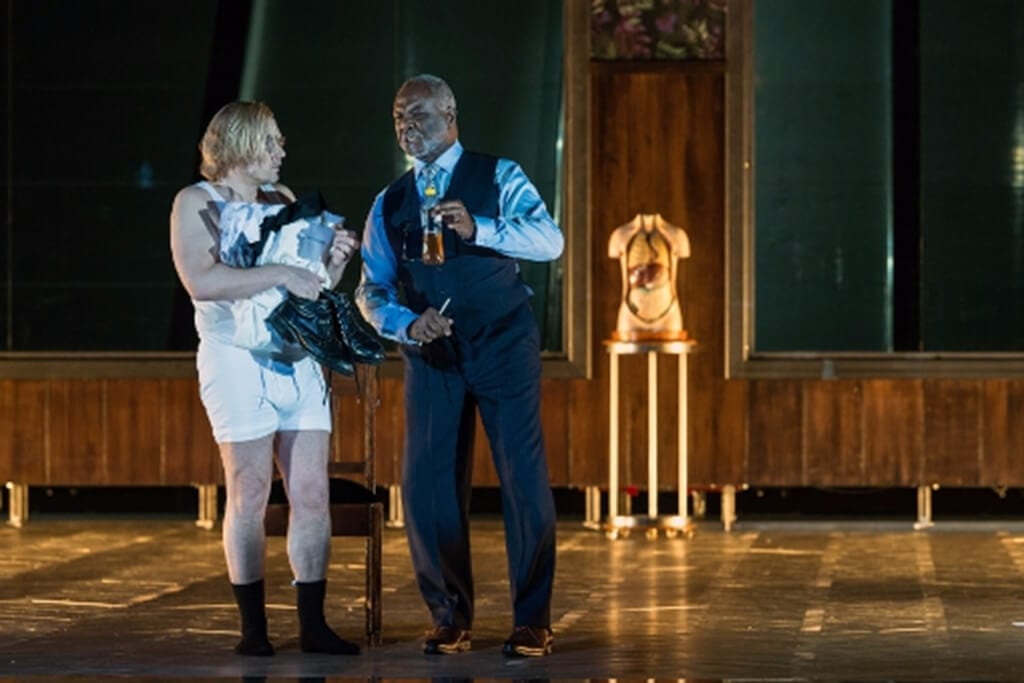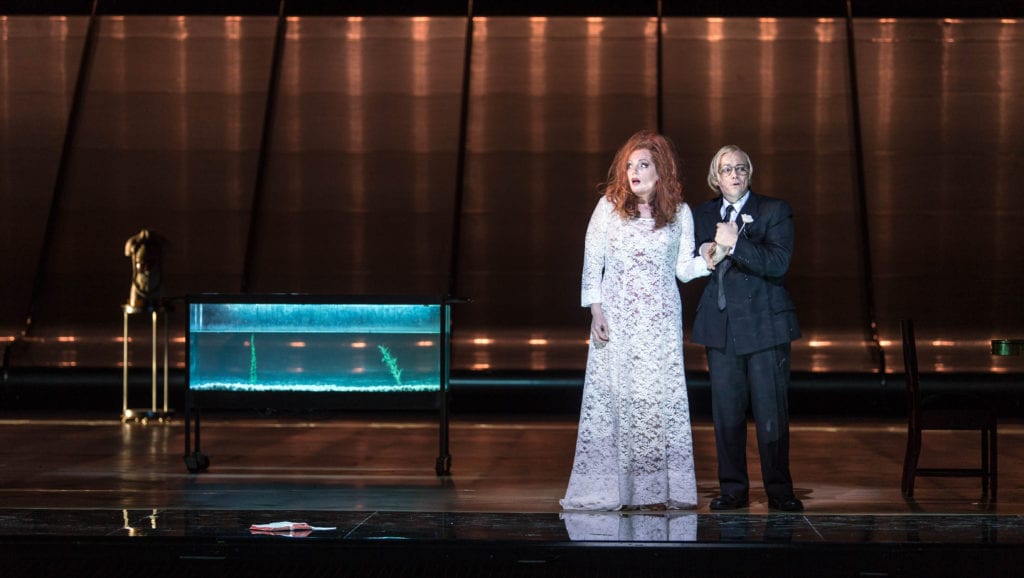The chimera of the perfect family unit haunts Krzysztof Warlikowski’s production of Wozzeck. On the unusually broad canvas of DNO’s stage, all of the characters struggle with isolation. In an extended added scene, the show begins with a dance contest featuring groomed and socially acceptable pairs of children–eleven and a half of them. The half is important, for she invites Wozzeck’s son to join her but he can’t quite manage. Into this frame Wozzeck emerges as a janitor, sweeping the floors as the children heartlessly mock him, launching a cyclical story in which multiple generations of perpetrators and victims come into view.
It has become a common strategy to bring Wozzeck’s son to the foreground as witness and helpless bystander. In this production, Wozzeck and Marie are also more present than called for. Wozzeck is part of the intimate scenario when Marie sings her lullaby to her son, for example, secluded from the rest of the dark stage through a rectangle spotlight (lighting design: Felice Ross). Marie cannot stay within this family portrait, however, and wanders into the darkness. Wozzeck’s actual arrival is signaled by his knocking, which switches on reality as cold light floods the stage. Was this Wozzeck’s dream, or even the boy’s? Later, Wozzeck remains frozen onstage after being examined by the doctor, and Marie entertains the Drum Major right beside him. In the barracks scene, Marie (in grotesque makeup) dances in the background as the Drum Major flaunts his virility.
The Captain and Doctor are an atypically contrasting pair. Marcel Beekman’s elaborate histrionics embrace the Captain’s commedia roots, with a complementary rich range of vocal colours and characters. Sir Willard White’s more reserved and sage, if jaded, Doctor meanwhile takes on strong Faustian and Freudian tones in his quest to crack Wozzeck’s psychic code. Christopher Maltman’s Wozzeck is streaked with emotion and humanity, his gentle optimism still partly intact when he delivers his earnings to Marie. His transformation into murderer is the chillingly controlled logical outcome of the reality around him. Eva-Marie Westbroek’s role debut as Marie is exciting and powerful, her scenes with her son–well-performed by Jacob Jutte–especially penetrating. Frank von Aken (Drum Major), Jason Bridges (Andres), Ursula Hesse von den Steinen (Margret), together with Scott Wilde and Morschi Franz (the two apprentices) all gave strong performances.
Warlikowski integrates a dark fairytale narrated in Büchner’s drama into the opening of Act II. Spoken by the boy, it exposes nature as offering no refuge, and his imminent orphan status is uttered in the bluntest of terms. The scene plays out in front of the stage curtain–a shimmering, textured suggestion of a forest, enlivened with mercurial gestures from the Netherlands Philharmonic Orchestra led by Marc Albrecht. But we know it’s an illusion. Through to the end of the act, the idea of performance rendered transparent is magnified. The apprentices enact a cabaret performance alongside the tavern ensemble, while all of the young dance couples fill out the scene. But when Wozzeck returns after killing Marie, the tavern is almost empty. In between, the representation of society, or at least the world in Wozzeck’s mind, has devolved into a surreal circus. Marie’s recourse to the Bible blends into the arrival of Wozzeck–her redemptive Saviour– with a wedding gown that he dresses her in before leading her to the fateful pond.
Real water onstage is encased in an aquarium in which Wozzeck hides his murder weapon, but Warlikowski’s longtime set designer Malgorzata Szczęśniak integrates reflective surfaces that are even more key to the concluding action. The shiny surface at the apron of the stage might resemble a pond’s edge, but Marie then uses her ebbing energy to drag herself to a broad metallic ramp at the back of the stage, while the timpani strokes that cap the apocalyptic crescendo accent her eventual collapse. Wozzeck, too, struggles physically after drowning; the Doctor and Captain hear something real as they pass by.
Warlikowski weaves visual imagery throughout the musical transitions, as the cavernous set transforms in often ingenious ways. Albrecht was able to showcase the orchestra’s nuanced reading of the score throughout. During the last transition, the great Mahlerian lament following Wozzeck’s death, the emotional landscape is cleaved in two. Sadly wise-before his years, in funereal black, the boy sees his dead parents and then slowly removes the organs from the Doctor’s anatomical model, starting with the heart. He doesn’t flinch when dozens of brightly dressed children use the ramp as a giant slide to rush onto the scene. It’s not the usual tear-jerking close, but unfolds convincingly given that the loss of innocence is already an old tale. Judging by the sustained appreciative response and post-performance buzz, this production (initially mounted in Warsaw in 2006) deserves further revivals.




